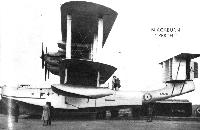
Описание
Страна : Великобритания
Год : 1933
Летающая лодка
Пятиместная дальняя летающая лодка
Варианты
- Blackburn - Iris / R.B.1 - 1926 - Великобритания
- Blackburn - Perth / R.B.3 - 1933 - Великобритания
Blackburn RB.3 Perth
Разработанный на основе RB.1 Iris гидроплан Blackburn RB.3 Perth предназначался для замены летающих лодок, состоявших на вооружении 209-й эскадрильи британских ВВС. От гидросамолета Iris V его отличала закрытая кабина и обшивка корпуса из коррозиеустойчивого материала. Для борьбы с кораблями в носовой части корпуса установили 37-мм пушку C.O.W., но была предусмотрена возможность замены орудия 7,7-мм пулеметом.
Первый полет Perth выполнил 11 октября 1933 года. Эксплуатация летающей лодки началась в январе 1934-го, когда второй экземпляр доставили в Плимут. Первый же в это время еще проходил испытания в Феликстоу. К 31 мая 1934 года все три построенных летающих лодки были переданы заказчику. Perth стал самым большим гидропланом бипланной схемы в истории британских ВВС. Вслед за самолетами первой партии последовал заказ на постройку четвертой машины, которая поднялась в воздух в апреле 1934 года, однако она осталась в Феликстоу, где использовалась для различных экспериментов.
Неудачное хвостовое оперение заставило провести его переделку, прервавшую на несколько месяцев эксплуатацию гидросамолетов. Первый Perth был потерян в сентябре 1935 года в бурном море, когда у него оторвался поплавок. Два из трех оставшихся самолетов списали в 1936 году. Четвертая машина летала в Феликстоу до 1938 года.
ТАКТИКО-ТЕХНИЧЕСКИЕ ХАРАКТЕРИСТИКИ
Blackburn RB.3 Perth
Тип: пятиместная дальняя летающая лодка разведчик/бомбардировщик
Силовая установка: три V-образных мотора Rolls-Royce Buzzard IIMS мощностью по 825 л, с.
Характеристики: максимальная скорость на уровне моря 212 км/ч; крейсерская скорость на оптимальной высоте 175 км/ч; скороподъемность 244 м/мин; практический потолок 3500 м; дальность 2400 км
Масса: пустого 9492 кг; максимальная взлетная 17240 кг
Размеры: размах крыла 29,57 м; длина 21,34 м; высота 8,06 м; площадь крыльев 233,27 м2
Вооружение: 37-мм пушка или 7,7-мм пулемет на турели в носовой части корпуса, 7,7-мм турельный пулемет в средней части корпуса, 7,7-мм пулемет в хвостовой части корпуса; до 907 кг бомб на внешней подвеске под крылом
Описание:
- Blackburn RB.3 Perth
- Flight, October 1933
THE BLACKBURN "PERTH”
Фотографии
-
Мировая Авиация 57
Регистрационный номер: K4011 Вместо 37-мм пушки в носовой части корпуса летающей лодки Perth установлен 7,7-мм пулемет Lewis.
-
Flight 1936-04 / Flight Advertisements
LONG-RANGE FLYING BOAT FOR COAST DEFENCE: A "Perth" (three "Buzzards") of No. 209 (F.B.) Squadron at Mount Batten
-
Flight 1936-05 / Flight
A PULLER OF PERTH: The fifty-ton crane on the jetty at Felixstowe, bringing ashore a Blackburn Perth flying boat (three 825 h.p. Rolls-Royce Buzzards). This picture was secured from the jib of the crane.
-
Air-Britain Aeromilitaria 1986-02
Регистрационный номер: K3582 -
Air-Britain Aeromilitaria 1987-03
Регистрационный номер: K3581 Perth K3581 was struck off charge in 1936 but was retained at the Marine Aircraft Experimental Establishment, Felixstowe, as a hulk for testing the forces on a moored flying boat through wind and weather at the end of 1938.
-
Flight 1934-06 / Flight
Blackburn "Perth" (three Rolls-Royce "Buzzard" II.MS) with a 37 mm. shell-gun. Note the flare of the vee bottom towards the bows.
-
Flight 1933-10 / Flight
WARMING UP: The central Rolls-Royce "Buzzard" engine is mounted on trestle struts, while the outboard engines are supported by the sloping interplane struts.
The Blackburn Perth (3 Buzzards) with side radiators on the nacelles. -
Flight 1934-01 / Flight
A YORKSHIRE SUNRISE: Launching the second of the four Blackburn "Perths" (Rolls-Royce "Buzzard II MS") at Brough on January 5. After the usual half-hour's flight by the company's test pilot, Mr. Blake, the machine was handed over to a R.A.F. crew from Mount Batten, who, under the command of Sqd. Ldr. J. H. O. Jones, of No. 209 (Flying Boat) Squadron, flew the machine non-stop to Plymouth, where it arrived the same afternoon.
-
Flight 1933-10 / Flight
Регистрационный номер: K3580 [3] THE AERIAL BATTLE CRUISER: The people in the background give a good idea of the size of the Blackburn "Perth."
-
Flight 1935-01 / Flight Advertisements
BLACKBURN "PERTH" FLYING-BOAT 3 ROLLS-ROYCE "BUZZARD" ENGINES
-
Flight 1933-10 / Flight
2,760 B.H.P. The Rolls-Royce "Buzzard" II MS. engines of the Blackburn "Perth."
-
Flight 1933-10 / Flight
Регистрационный номер: K3580 [3] THE "CRUISER STERN": Note the gunner's tail defence position. The rudders are provided with servo flaps.
-
Flight 1933-10 / Flight
AERIAL ARTILLERY: The Blackburn "Perth" flying boat is equipped with a 37-mm. gun firing shells weighing about 1 1/2 lb.
-
Flight 1934-07 / Flight
FLYING BOATS: One of the most interesting events of the Display was the "fly past" of flying boats. Three of them are shown here - the Saunders-Roe R.24/31 (two Bristol "Pegasus") (left); the Short R.24/31 (two Rolls-Royce "Goshawk") (centre); and the Supermarine "Scapa" (two Rolls-Royce "Kestrel"), all of the open-sea reconnaissance multi-seater type. This photo was taken from another of the flying boats, the Blackburn "Perth" (three Rolls-Royce "Buzzard"), during rehearsals at Felixstowe.
Другие самолёты на фотографии: Saunders-Roe London / A.27 - Великобритания - 1934Short Knuckleduster / S.18 - Великобритания - 1933Supermarine Scapa - Великобритания - 1932
-
Flight 1933-12 / Flight Advertisements
BLACKBURN "PERTH" FLYING BOAT 3 ROLLS-ROYCE BUZZARD ENGINES
-
Мировая Авиация 57
Blackburn Perth
- Фотографии

















